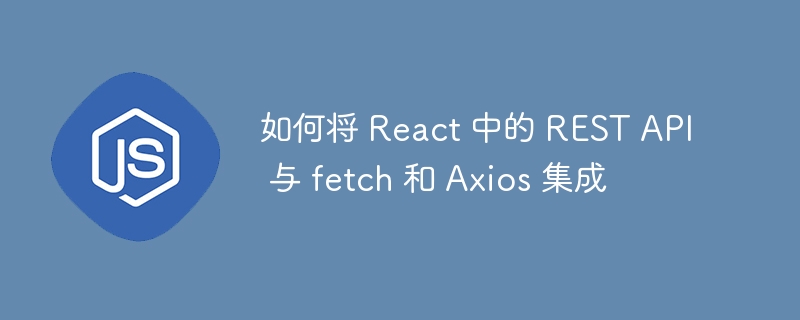
在 React 应用中集成 REST API
将 REST API 集成到 React 应用是前端开发的常见需求。REST (Representational State Transfer) 是一种架构风格,允许通过 HTTP 方法 (GET, POST, PUT, DELETE 等) 与外部资源 (数据) 交互。React 可以轻松地与 REST API 集成,实现高效的数据获取、新增、更新和删除操作。
本文将介绍如何使用 fetch API 和 Axios 等方法在 React 应用中集成 REST API,并处理异步数据获取。
1. 从 REST API 获取数据
JavaScript 内置的 fetch() 函数提供了一种简单的发出 HTTP 请求的方法。它返回一个 Promise,该 Promise 解析为包含请求响应的 Response 对象。
使用 fetch API 获取数据以下示例演示如何使用 fetch API 从 REST API 获取数据并在 React 组件中显示:
1
2
3
4
5
6
7
8
9
10
11
12
13
14
15
16
17
18
19
20
21
22
23
24
25
26
27
28
29
30
31
32
33
34
35
36
37
38
39
40
41
42
43
44
45
46
47
import React, { useState, useEffect } from react;
const apiUrl = https://jsonplaceholder.typicode.com/posts; // 示例 REST API
const FetchPosts = () => {
const [posts, setPosts] = useState([]);
const [loading, setLoading] = useState(true);
const [error, setError] = useState(null);
useEffect(() => {
// 从 API 获取数据
fetch(apiUrl)
.then(response => {
if (!response.ok) {
throw new Error(网络响应不正常);
}
return response.json();
})
.then(data => {
setPosts(data);
setLoading(false);
})
.catch(error => {
setError(error.message);
setLoading(false);
});
}, []);
if (loading) return <div>加载中...</div>;
if (error) return <div>错误: {error}</div>;
return (
<div>
<h1>文章列表</h1>
<ul>
{posts.map(post => (
<li key={post.id}>
<h2>{post.title}</h2>
<p>{post.body}</p>
</li>
))}
</ul>
</div>
);
};
export default FetchPosts;
2. 使用 Axios 进行 API 请求
Axios 是一个基于 Promise 的 HTTP 客户端,适用于浏览器和 Node.js。它提供比 fetch 更简洁的语法,并支持自动 JSON 转换、请求取消等附加功能。
安装 Axios使用 npm 安装 Axios:
1
npm install axios
以下示例与上一个示例相同,但使用 Axios:
1
2
3
4
5
6
7
8
9
10
11
12
13
14
15
16
17
18
19
20
21
22
23
24
25
26
27
28
29
30
31
32
33
34
35
36
37
38
39
40
41
42
import React, { useState, useEffect } from react;
import axios from axios;
const apiUrl = https://jsonplaceholder.typicode.com/posts;
const FetchPostsAxios = () => {
const [posts, setPosts] = useState([]);
const [loading, setLoading] = useState(true);
const [error, setError] = useState(null);
useEffect(() => {
// 使用 Axios 从 API 获取数据
axios.get(apiUrl)
.then(response => {
setPosts(response.data);
setLoading(false);
})
.catch(error => {
setError(error.message);
setLoading(false);
});
}, []);
if (loading) return <div>加载中...</div>;
if (error) return <div>错误: {error}</div>;
return (
<div>
<h1>文章列表</h1>
<ul>
{posts.map(post => (
<li key={post.id}>
<h2>{post.title}</h2>
<p>{post.body}</p>
</li>
))}
</ul>
</div>
);
};
export default FetchPostsAxios;
3. 向 REST API 发送数据 (POST 请求)
除了 GET 请求,还可以使用 POST 请求向服务器发送数据,通常用于提交表单或创建新记录。
使用 fetch 发送 POST 请求1
2
3
4
5
6
import React, { useState } from react;
const postUrl = https://jsonplaceholder.typicode.com/posts;
const CreatePost = () => {
const [title, set
以上就是如何将 React 中的 REST API 与 fetch 和 Axios 集成的详细内容,更多请关注php中文网其它相关文章!

